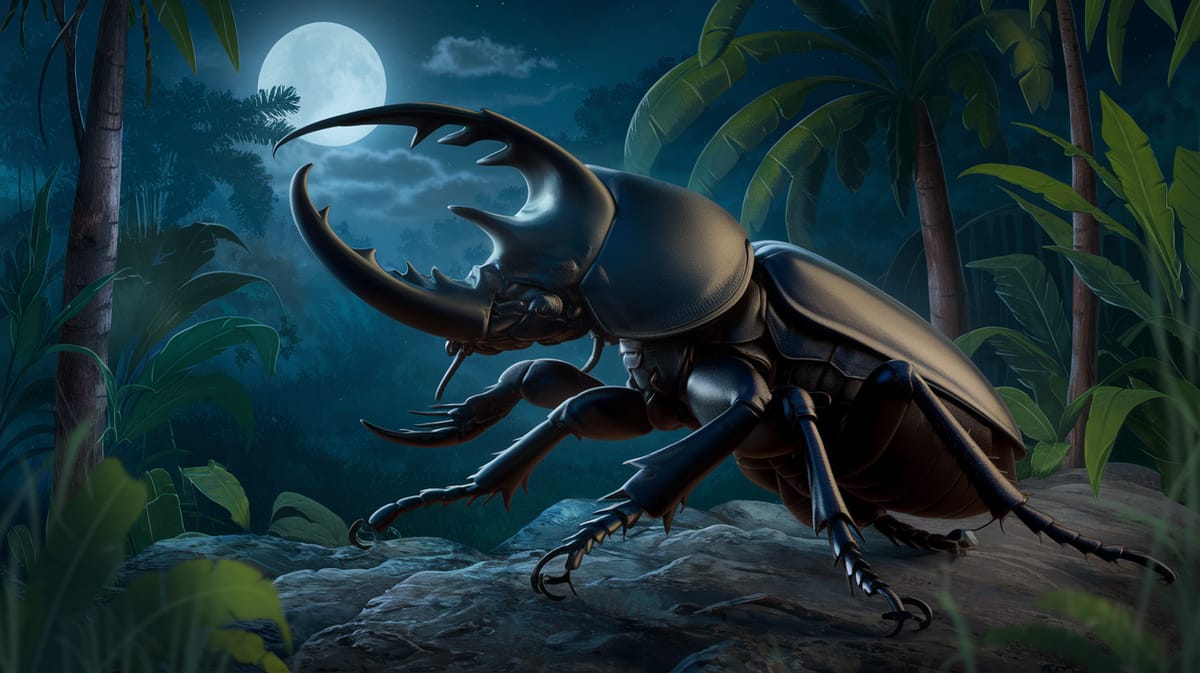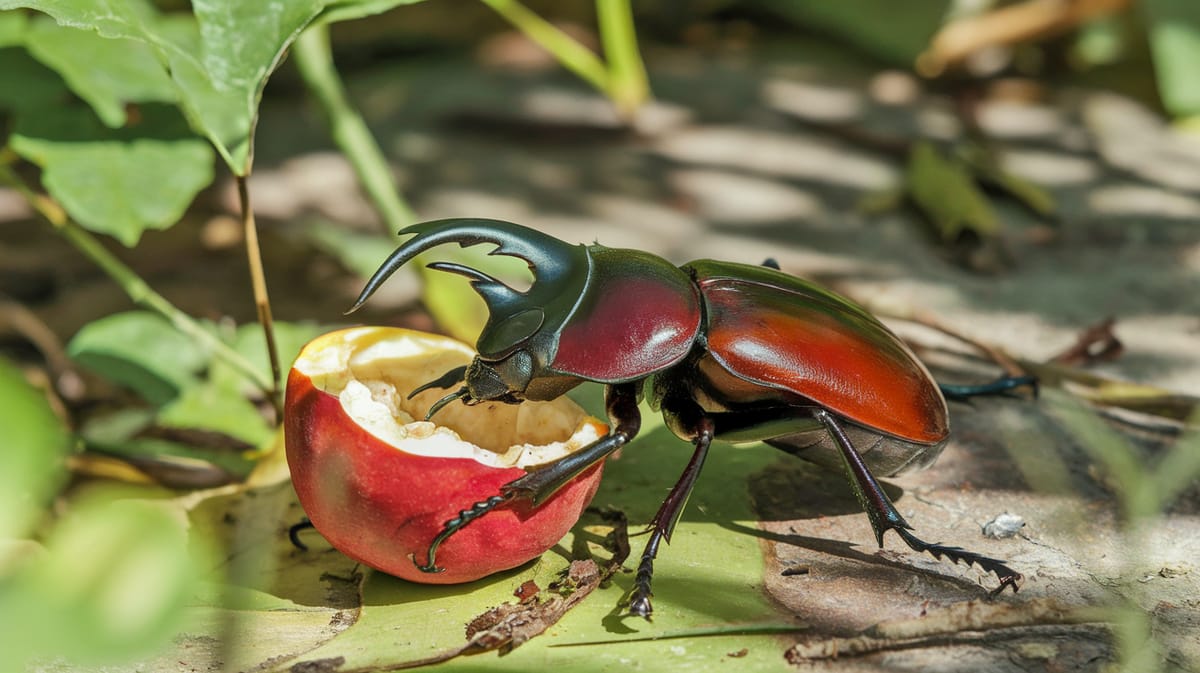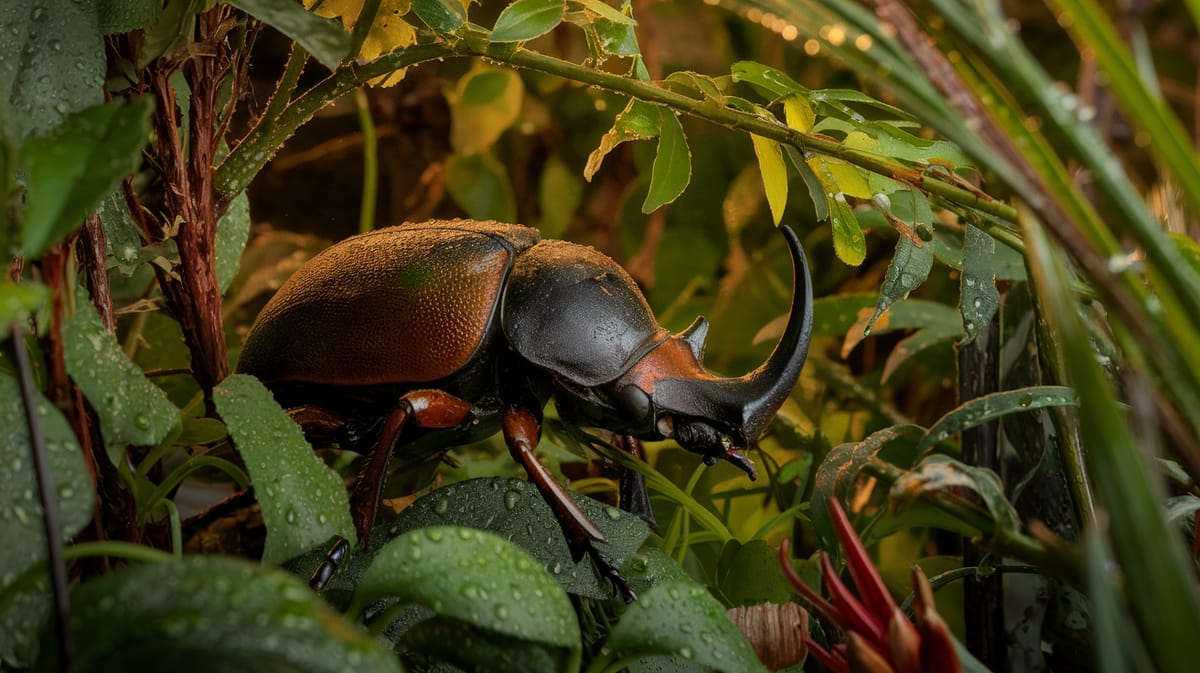Rhinoceros Beetle
With its impressive horn and incredible strength, the Rhinoceros Beetle is a marvel of nature, capable of lifting up to 850 times its own weight. Playing a crucial role in decomposing organic matter, it helps maintain ecological balance.

Key Insights at a Glance
Did You Know?
Taxonomy & Classification
Rhinoceros beetles showcase incredible strength, with their horned exoskeletons symbolizing an evolutionary adaptation for combat and survival across various ecosystems. Let's understand the evolutionary journey and classification of these remarkable Decomposers, Herbivores.
Global Presence
Rhinoceros beetles inhabit regions worldwide, with about 300 species spreading from tropical to temperate zones, showcasing their adaptability.
Evolutionary Resilience
Dating back to the late Jurassic period, they have thrived through major climatic shifts, adapting with tough exoskeletons and powerful horns.
Lifecycle and Growth
A remarkable journey of transformation from Egg to Adult.
Egg
Laid in decomposing plant matter, eggs develop into larvae, drawing nutrients from their surroundings to ensure growth.
Larva
Feeding voraciously on decaying wood, larvae grow significantly, preparing for their next transformation into pupae.
Pupa
Encased in a cocoon-like structure, the pupa undergoes metamorphosis, transforming into a fully developed adult beetle.
Adult
Emerging with a distinctive horn, adults focus on reproduction and territory establishment, often engaging in battles for mates.
Dietary Habits
A plant-feeder with specialized mouthparts, this insect primarily consumes sap and decaying plant matter, adapting to various environments.
| DIET TYPE | DESCRIPTION |
|---|---|
| Primary Diet | Primarily feeds on tree sap, decaying wood, and plant matter, efficiently using its strong mandibles. |
| Secondary Diet | Occasionally consumes fruits, bark, and leaves, supplementing its diet when primary sources are scarce. |
| Occasional | Rarely eats smaller insects or larvae, especially in nutrient-poor conditions, reflecting its adaptability. |

Behaviour and Adaptations
Discover the impressive traits that enable the Rhinoceros Beetle to thrive in its environment.
Horned Combat
Males use horns to compete for mates and territory, showcasing strength.
Nighttime Activity
Primarily nocturnal, reducing predation risk while foraging.
Strong Exoskeleton
Protects against predators and environmental hazards, ensuring survival.
Ecosystem Impact
Rhinoceros Beetles play crucial roles in sustaining ecosystem health and diversity.
Nutrient Recycler
Decomposes dead wood, enriching soil quality and aiding plant growth.
Food Chain Component
Serves as prey for birds and small mammals, supporting biodiversity.
Habitat Engineer
Creates habitats by burrowing, influencing soil structure and aiding other organisms.
Conservation Challenges
Understanding and addressing the major threats to Rhinoceros Beetle populations.
Habitat Destruction
Deforestation and land conversion reduce the beetle's natural habitats.
Chemical Exposure
Pesticides and pollutants threaten beetle survival and reproductive success.
Invasive Species
Non-native species compete for resources and alter ecosystems.
Frequently Asked Questions
How long do Rhinoceros Beetle live?
Rhinoceros Beetles typically live for three to six months as adults. Their entire life cycle, including the larval and pupal stages, lasts about one to two years, depending on environmental conditions and food availability.
What do Rhinoceros Beetle eat?
As larvae, Rhinoceros Beetles consume decaying wood and plant matter. Adult beetles primarily feed on nectar, fruit, and tree sap. Their diet helps in nutrient recycling and maintaining ecological balance.
Are Rhinoceros Beetle poisonous?
Rhinoceros Beetles are not poisonous and pose no threat to humans. They are harmless creatures that do not produce venom or toxic substances. Their intimidating appearance is mainly for defense and mating displays.
Are Rhinoceros Beetle endangered?
Most Rhinoceros Beetle species are not endangered, although habitat destruction and pollution can threaten their populations. Conservation efforts help protect their natural habitats to ensure their survival.
What do Rhinoceros Beetle symbolize?
In various cultures, Rhinoceros Beetles symbolize strength, courage, and protection due to their impressive size and horned appearance. They are often seen as symbols of resilience and determination.
Do Rhinoceros Beetle bite?
Rhinoceros Beetles do not bite humans. They are gentle insects and use their horns primarily for fighting other beetles during mating competitions. They pose no risk of biting or stinging.
What color are Rhinoceros Beetle?
Rhinoceros Beetles are typically dark brown or black. Some species may have shiny, metallic-looking bodies due to their smooth, hard exoskeletons that can reflect light.
Does a Rhinoceros Beetle have wings?
Yes, Rhinoceros Beetles have wings. They possess a pair of hard outer wings called elytra that protect their delicate flying wings underneath. These wings enable them to fly, although they are not agile flyers.
What does a Rhinoceros Beetle look like?
Rhinoceros Beetles are large, robust insects with a hard exoskeleton. They have prominent horns on their heads, which vary in shape and size among species. Their bodies are typically dark and shiny.
Is a Rhinoceros Beetle an insect?
Yes, a Rhinoceros Beetle is an insect. It belongs to the order Coleoptera, which includes all beetles. Like all insects, they have a segmented body with a head, thorax, and abdomen, six legs, and antennae.
Related Insects
Discover insects with similar characteristics to Rhinoceros Beetle - including shared habitats, diets, and taxonomic classifications
Share this profile
Help others discover Rhinoceros Beetle
